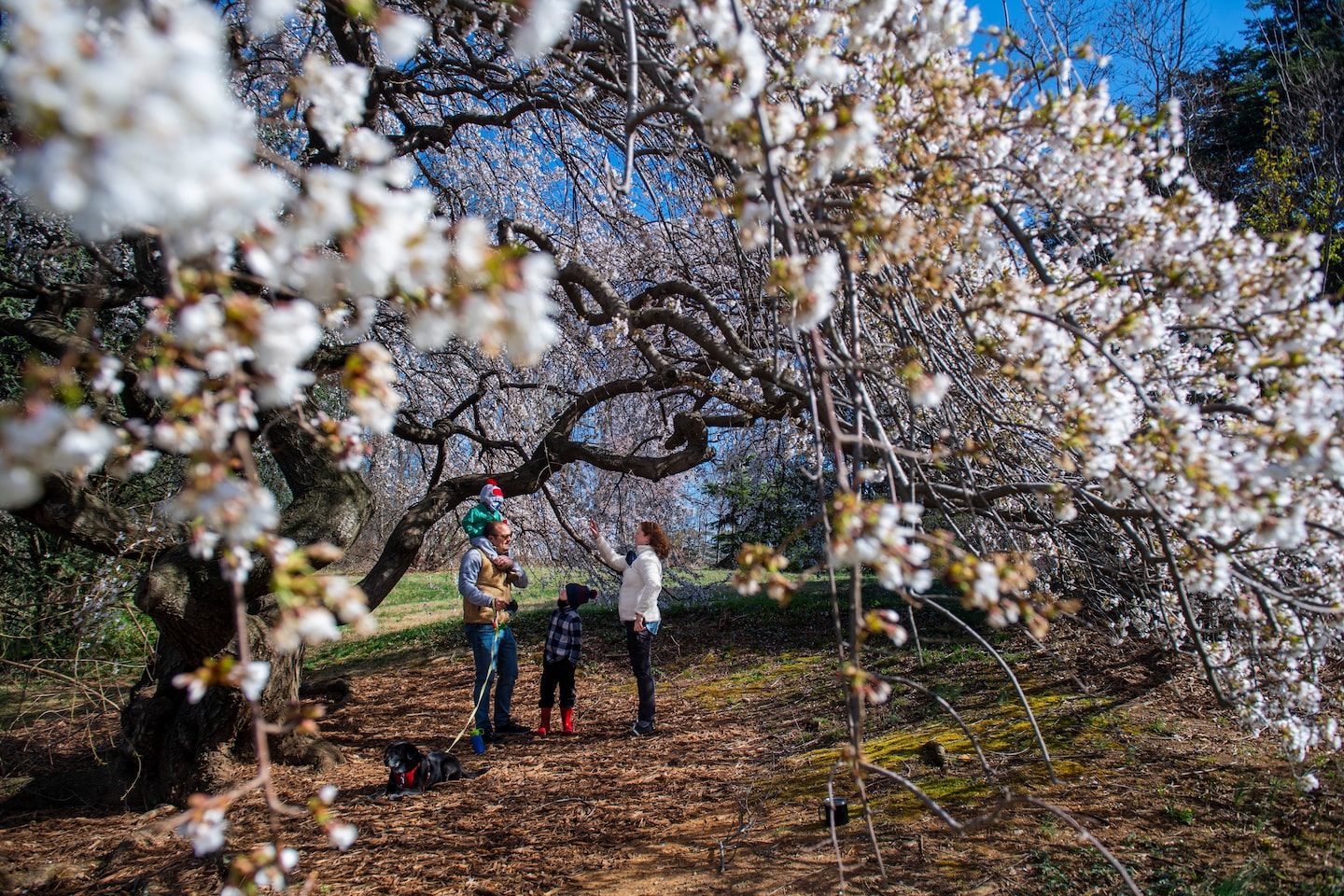The advantages of spending an afternoon at the arboretum are apparent: Wide-open roads! Few cars! The ability to wander off the pavement and touch the grass between trees, and even spread out picnic blankets with views of flowering cherries and a pond in the distance! All this before we even get to the blossoms themselves.
More than 70 varieties of cherry trees grow across the arboretum’s 446 acres, including three hybrids that were actually developed there. While seeking out hundreds of cherry blossoms among all the other flowering plants, majestic trees and carefully tended gardens might sound daunting, it’s made much easier with the free self-guided tour, available as a printed brochure in the arboretum’s visitor center and found on its smartphone app.
The latest iteration of the tour has grown from 27 stops to 40, allowing the arboretum to showcase trees along Azalea Road in the southwest corner of the grounds. These were featured on tours more than a decade ago, says arboretum interpretive specialist Julia da Silva, until the arboretum’s resident bald eagles built a nest nearby and the area was closed to visitors. “In 2023, the eagles built a nest elsewhere in the arboretum for the first time,” da Silva says. “When it became clear that they’d not be returning to their old nest, we decided it was time to bring those trees along Azalea Road back into the tour. Some of these trees are among the rarest in our collection, so it’s a treat to be able to share them with the public again.”
They include the green-flowered Gyoiko, a rare tree first collected in Japan in 1915 by Agriculture Department “plant explorer” Frank Meyer, which is found at only one or two arboretums in the United States, and the fragrant Wase-miyako, which the arboretum says is “likely” the only one in the country.
Unlike the flowers at the Tidal Basin, which tend to explode into a forest of pink at the same time, peak bloom for the varieties of trees at the arboretum ebbs and flows, from “early” (mid-late March) through “late-flowering” (mid-late April). On a recent visit, the deep pink flowers of the First Lady — one of the hybrids created here — were putting on a show in multiple fields, while other trees were just beginning to bud or still showing bare branches.
Each stop is marked with a large pink placard. Look up that number in the brochure or on the app to find a photo of the blossoms (helpful if the trees aren’t in bloom) and a biography of the plant: It’s interesting to learn that the Yoshino at Stop 29 is a clone of one of the trees that first lady Helen Taft originally planted at the Tidal Basin in 1912. On the other side of the arboretum, near the Administration Building, is a cultivar developed at the arboretum named after Taft, developed from a clone of an original Yoshino.
The trees are primarily clustered in a few locations, but the tour also leads to some unexpected places, such as the Research Fields, a beautiful, sun-dappled grove containing trees grown from seeds collected in Japan, experimental hybrids and plants used for breeding and preservation. Consider them works in progress, says Margaret Pooler, the research leader of the arboretum’s Floral and Nursery Plants Research Unit: “They are part of our in-progress hybridization program and are not part of the permanent arboretum display collections,” so they don’t have identification tags.
Getting in close to smell the blossoms and take photos brings clear reminders that we’re not the only living things enjoying the return of spring: Approaching the cherry blossoms and Japanese apricot trees in the fields along Hickey Hill Road, a droning hum got louder with every step, thanks to bees buzzing and flitting between the scented flowers carpeting every branch.
That connection to nature is what makes encountering cherry trees at the arboretum different from the Tidal Basin or Hains Point. Exploring is worthwhile: Da Silva, the interpretive specialist, hopes visitors do stray off the marked path, to places like a corner of the flowering tree collection at Crabtree and Hickey Hill roads ideal for a picnic. “The land rises away from the intersection,” da Silva says. “Not much, but just enough that I think a lot of people don’t bother to head up that way. It’s very peaceful, there’s a few spots to sit, and you have a view over the flowering trees and across to Beechwood Pond. It’s lovely. Folks heading to Stops 17 and 18 will find the spot.”
Another tip: Don’t miss the weeping cherries outside the National Herb Garden, the oldest in the arboretum’s collection, whose knobby branches are supported by traditional Japanese crutches.
The tour’s total walking distance is about three miles, according to the arboretum, but that’s not required: There are parking lots at different areas — the spaces near the Research Fields, Stop 35, allow access to a number of trees a short walk away, as do small lots near the conifer and dogwood collections.
Before long, you’ll start to notice more cherry blossoms that aren’t highlighted on the tour — such as the First Lady tree sitting along Eagle Nest Road, facing the National Capitol Columns, offering a rather lovely photo opportunity across the Ellipse Meadow. And you’ll probably be making plans to come back in a week or two, when different trees might be in bloom.
The U.S. National Arboretum is open daily from 8 a.m. to 5 p.m. Car access is allowed through the gate at 2400 R St. NE until 2 p.m. Monday through Friday. After that, cars must enter through 3501 New York Ave. NE. Free.


